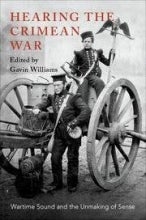Review | Hearing the Crimean War

Hearing the Crimean War: Wartime Sound and the Unmaking of Sense. Ed. by Gavin Williams. New York: Oxford University Press, 2019. li, 268. Bibliography. Index. $41.95, paper.
This event, symbolic of the burgeoning possibilities and pitfalls of young global
communication networks, becomes a touchstone for the essay collection Hearing the
Crimean War: Wartime Sound and the Unmaking of Sense, edited by Gavin Williams. This
war occupies a place of particular importance in world military history, being the first
conflict to experience battles on multiple fronts, some of which employed trench warfare, and
to make extensive use of technological novelties of the industrial revolution. In addition to
major developments in transit and medicine, innovations in telegraphy and photography made
the Crimean War viscerally present in the domestic sphere in a way previously unimaginable.
These media technologies, which presented new possibilities for reportage, brought the
war home, but the war was (by definition) mediated, often by far-from-neutral sources.
Williams, in addition to the nine other authors included in the collection, address the issue of
media and mediation in manifold ways. In this respect, the collection attempts to amplify the
silences of the archives: what was communicated, recorded, and what has been omitted from
history? Where were the notable gaps? Where was media’s activity, its non-neutrality, most
evident, and how did it shape the war itself in addition to public perception? Sound and
silence thus become, far from opposites of one another, two sides of the same coin, both
worthy objects of study for the authors of the collection.
Although all of the book’s contributors necessarily address this issue to some extent,
the first group of essays, “Sound, Technology, Sense,” examines this theme explicitly, to rich
reward. Among the standout essays is Williams’ own contribution, “Gunfire and London’s
Media Reality: Listening to Distance between Piano, Newspaper and Theater,” which
examines depictions of gun- and cannon fire in popular piano music written by British
composers during the Crimean War. These pieces, functionally musical propaganda,
drummed up support on the domestic front by placing the war squarely in the living room and
providing women, to whom the pieces were most actively advertised, a role to play in
warmaking. Peter McMurray’s essay “The Revolution Will Not Be Telegraphed: Shari’a Law
as Mediascape” impresses with its extensive investigation of the origins of legality in Islamic
thought, concentrated in the power of the human voice, and examines the complex effect the
telegraph has on this metaphysical process.
concerns, and come to the fore in the second section, “Voice at the Border.” In their essays,
Andrea Bohlman and Delia Casadei explore the ways that the folk musics of Poland and
Italy, respectively, were used to generate support for the conflict through national identity.
Music, they argue in their essays, offered a useful, visceral definition of nationhood and
given culture and writing over its shortcomings. The developing notion of cosmopolitanism
becomes especially important for this section: all three essays address the changing
conception of Europe as an area made up of independent parts but with limits to a defined
identity. Especially notable is Kevin C. Karnes’ entry on the “Song of the Russian Soldier,”
which touches on the project of mapping Europe, including the creation of an ‘Eastern’
Europe that contrasted a ‘Western’ one.
The collection turns more explicitly in its last part to the project of war. Tolstoy’s
Sevastopol Sketches receive deserved treatment in Alyson Tapp’s essay “Earwitness,” which
very appropriately focuses on the sensensational (in the literal meaning of the word) aspect of
Tolstoy’s prose. As a participant in the war and a great author of the psychology of battle,
Tolstoy’s observations on what soldiers experience while fighting, what war looks like from
the inside, carry a great deal of weight. Tapp’s close reading brilliantly elucidates the
subtleties of these observations.
As this brief overview of selections from the volume show, while the majority of
Hearing the Crimean War’s authors are musicologists (Williams’ own area of research), this
is not a strict limitation. Clearly, sound studies is an interdisciplinary enough field to
incorporate contributions from diverse backgrounds, many of which effectively complement
one another. The first section, “Sound, Technology, Sense,” benefits in particular from a wide
scope of research: the several disciplines represented here (including literature, legal studies,
musicology, and anthropology) all offer invaluable tools to future research in sound studies,
as all present useful avenues to examine historical sounds and their perception—no easy task.
Placing them next to one another demonstrates the comprehensiveness this mode of analysis
may offer via a diversity of media and perspectives.
At times, however, this broadness does not elucidate but rather complicates the object
of study. Williams is keenly aware of the issues surrounding the interdisciplinarity of his
collection and addresses them immediately in the introduction, which attempts to connect the
2014 invasion of Crimea by Russian forces, the 2003 bombing of Baghdad, and a night from
the height of the Crimean War. The connective tissue he describes—the role of sound in
sensing and experiencing armed conflict—gave this reader a significant helping hand in
understanding the critical framework of the pieces to follow, but it is difficult to ignore the
temporal lopsidedness of this introduction, and the rather artificial character of its creation.
Nevertheless, although the insights stray far afield of sound studies in the strictest sense, the
insights the essayists provide prove useful to understanding the cultural and political impact
of the Crimean War, and show promise of having a lasting effect on historical sound studies.
Cooper Lynn is a second-year PhD student at UCLA in the Department of Slavic, East European & Eurasian Languages and Cultures. His primary interests include émigré literature, memory studies, and performance studies.





